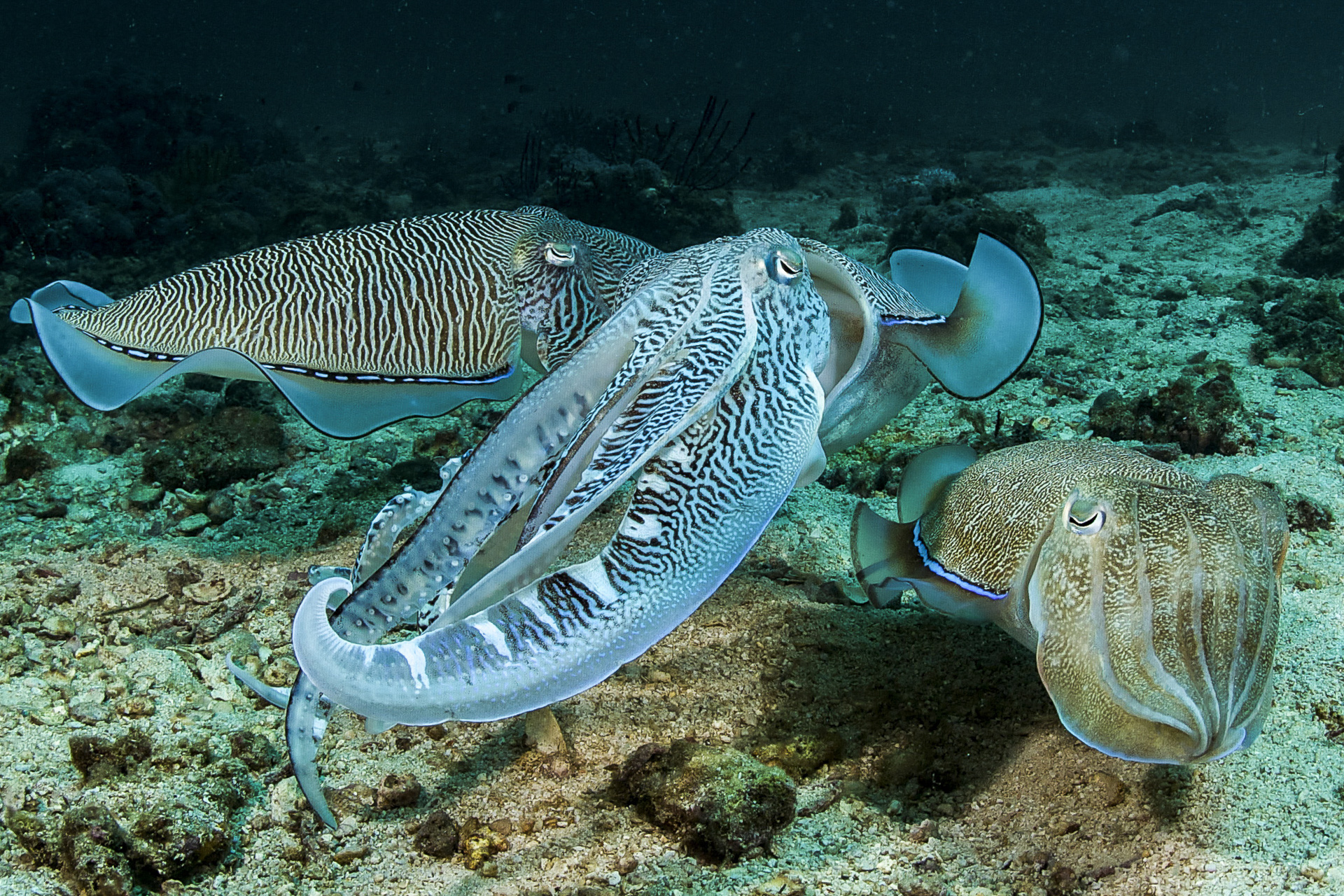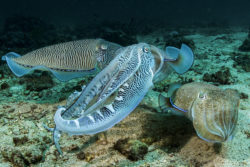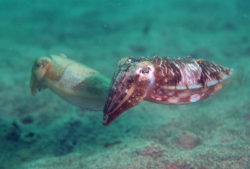
Sea Wonder: Cuttlefish
Cuttlefish (order Sepiida) are marine mollusks related to squid, octopuses, and the chambered nautilus. We don’t blame you if you’ve mixed these cephalopods up since they share a lot of characteristics but we’re here to set the record straight. There are more than 120 distinct species of cuttlefish that inhabit the world’s ocean, all of which are mysterious, beautiful, and a sight worth seeing on your next dive if you are lucky enough!
Description
Cuttlefish share characteristics with their genetic cousins, octopuses, squid, and nautiluses. Each species looks different from the next depending on where they live and the composition of the food webs to which they have adapted. In general, you could describe them as fat squids with short arms and tentacles. They have a mantle (the main body cavity that contains their internal organs) like squid and a long, wavy fin used for movement that runs down the side of it. Cuttlefish vary in size but range from six to 20 inches in length.
Cuttlefish have two eyes, one on each side of their mantle, and W-shaped pupils. These animals – like their octopus cousins – are famous for their ability to change colors and in some cases textures to mimic their environments, despite being completely colorblind. Their camouflage abilities are made possible by chromatophores – pigmented skin cells and muscles that contract and expand to darken the skin. They have beaked mouths beneath the eight suckered tentacles that hang from their face, but no teeth. Their brain-to-body ratio is one of the largest of any invertebrate, larger than that of most species of octopus. They are well-adapted to quickly process and respond to environmental conditions, including sight, sound, and chemical changes in the water.
Similar to swim bladders in fish and oily livers in sharks, cuttlefish maintain buoyancy underwater using a specialized organ – their cuttlebone. No other animal has a cuttlebone, which is basically a hollow and porous internal shell made of aragonite, a form of calcium carbonate.
Diet & Habitat
Cuttlefish diets vary depending on where in the ocean they live, but they commonly feed on mollusks, shellfish, fish, octopus, worms, and even other cuttlefish. Their natural predators include dolphins, sharks, large fish, seals, seabirds, and other cuttlefish.
Just as varied as their diets are their hunting strategies, which depends on their environment and target prey. In general, cuttlefish are active and aggressive predators that use their color-changing abilities and movement of their tentacles to mesmerize their prey before grabbing it in a quick flash of movement. In some cases, cuttlefish may utilize an ambush strategy where they camouflage themselves, waiting until an unsuspecting morsel swims by and taking the opportunity to quickly grab and eat it. If cuttlefish are facing predation, they can push a stream of water out from their mantle to quickly propel them away from danger, at the same time making use of their ink sacs to expel a cloud of ink to confuse their attacker.
Cuttlefish live in tropical and temperate latitudes in the ocean and generally live in shallower waters near reefs, seagrass beds, and other productive habitats but not always. Some cuttlefish species can live at depths of nearly 2,000 feet! They are common in the eastern Atlantic Ocean, the Mediterranean Sea, the North and Baltic seas, and near northwestern Africa. Within the National Marine Sanctuary System, you are most likely to see a cuttlefish in one of the east coast sanctuaries like Stellwagen Bank, Gray’s Reef, and Florida Keys national marine sanctuaries.
Life History
Cuttlefish live short lives, with a maximum life span of one or two years depending on the species. They begin their lives as one of several hundred eggs a female will lay during the spring months. Eggs that aren’t swept away by the current or eaten by another animal hatch about 60 days after they are laid. Upon hatching, cuttlefish are miniature versions of their adult form at lengths of only a few millimeters. During their juvenile phase, they eat small crustaceans and plankton, growing rapidly and reaching their full size and sexual maturity as early as their first winter, with females maturing later than males.
Unlike other cephalopods, cuttlefish can be highly social and frequently interact with conspecifics. This social behavior isn’t always positive; cuttlefish are territorial and not afraid to fight other cuttlefish to keep them away. Scientists think their systems of communication are one of the most sophisticated of any marine invertebrate, and the subject of their individual and social intelligence is appealing to researchers who want to understand evolution, adaptation, and behavior in marine animals.
Due to their social nature mating rituals are complex, and with males outnumbering females in most populations, mating season can include displays of deadly aggression between competitive males. Mating behavior can include amazing displays of color change, bioluminescence, and even males posing as females to avoid physical confrontations with other males. Females may mate with one or many males in a given season, often choosing males who show mental prowess instead of physical strength or size.
Cuttlefish mate in a head-to-head fashion using specialized organs for fertilization. Females hold sperm and eggs in a sac located below her mouth and can somehow choose which male’s sperm she wants to fertilize her eggs. Males have also adapted mechanisms to displace the sperm of other males to increase the likelihood of passing on their own genetic material. Depending on where they live, reproduction occurs in the spring when waters are an ideal temperature and food is plentiful. Females lay their eggs and attach them to stable structures like grasses, rocks, or corals.
Threats & Conservation
Cuttlefish are important species in cephalopod fisheries in many countries, which means they are target species and also caught accidentally as bycatch. Changes in the ocean also pose a threat to cuttlefish species, including climate change, ocean acidification, chemical and physical pollution, and habitat loss related. We don’t have enough information to fully understand the population trends of all cuttlefish species, but the International Union for Conservation of Nature (IUCN) lists them as species of least concern.



